
Great Dane Puppy Training Tips
PETSIDI – Bringing home a Great Dane puppy is an exciting time! These gentle giants make wonderful companions when properly trained and socialized from a young age. Proper training for Great Dane puppies requires patience, consistency, and an understanding of the breed’s specific needs. This article provides tips and guidelines for training your Great Dane puppy using positive reinforcement techniques.
Crate Training
Crate training is highly recommended for Great Dane puppies. The crate provides a safe space for your puppy to rest and sleep. It also helps with housetraining by using their natural inclination to avoid soiling their sleeping area.
When starting crate training for Great Dane puppies:
- Choose a crate that allows enough room for your puppy to stand, turn around, and lie down. Partition off excess space until they grow into it.
- Make the crate comfortable with a bed and a few safe chew toys.
- Start crate training immediately so it becomes a normal part of their routine.
- Use treats and praise to reward your puppy for calmly entering the crate. Never force them inside.
- Keep initial crating sessions short and happy. Slowly increase duration.
- Take your puppy outside immediately before and after crating to encourage good potty habits.
- Avoid using the crate for punishment. It should only have positive associations.
With time and consistency, your Great Dane will learn to relax and settle in their crate. This allows you to leave them safely confined when you cannot supervise.
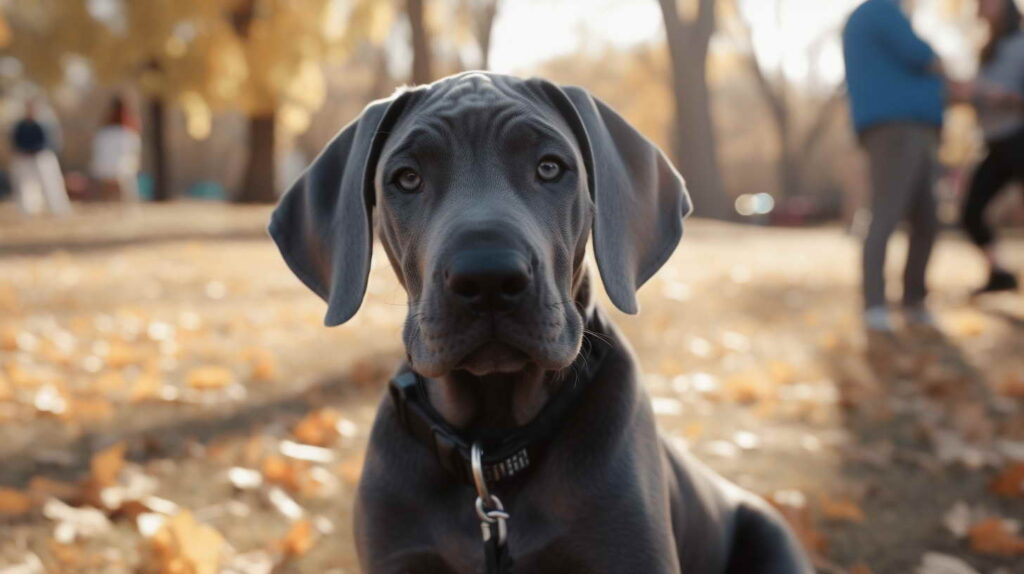
Obedience Training
Obedience training for Great Danes is essential for instilling important skills and manners. Formal training should start as early as 8-12 weeks old. Focus initial training on:
- Basic commands like sit, stay, come, down, heel
- Leash training for controlled walking
- Socialization with people, environments, and other dogs
- Housetraining
Use rewards like treats, praise, and play to reinforce desired behaviors. Be patient and keep training sessions brief for young puppies. Increase duration and complexity gradually as your Great Dane matures.
For best results, use positive reinforcement techniques during obedience training. This means rewarding good behavior and ignoring unwanted actions. Punishment or scolding should never be used.
Signs your Great Dane puppy is ready for more advanced obedience work include a basic understanding of commands, the ability to focus and engage with you, and being comfortable walking on a leash. Formal obedience classes provide great socialization experiences too.
Preventing Problem Behaviors
Proper training and socialization from a young age helps prevent problem behaviors in Great Danes. Here are some tips:
- Avoid physical punishment, which can cause fear and anxiety. Use positive reinforcement techniques instead.
- Provide appropriate chew toys to divert biting and chewing impulses during teething.
- Socialize your puppy safely to prevent fearfulness toward people or dogs.
- Teach children safe interaction with your Great Dane puppy to prevent injuries from rough play.
- Discourage jumping up through training and ignoring attention-seeking behaviors.
- Use baby gates, leashes and supervision to set rules and limitations inside your home.
- Address any emerging resource guarding using positive reinforcement and by hand-feeding meals.
- Crate train your puppy and provide stimulating toys in their crate to prevent destructive chewing behaviors when unsupervised.
Prevention is key, but if unwanted behaviors emerge, address them immediately through positive training techniques. Be patient, and consistent and avoid punishment. Consult a trainer for guidance if needed.
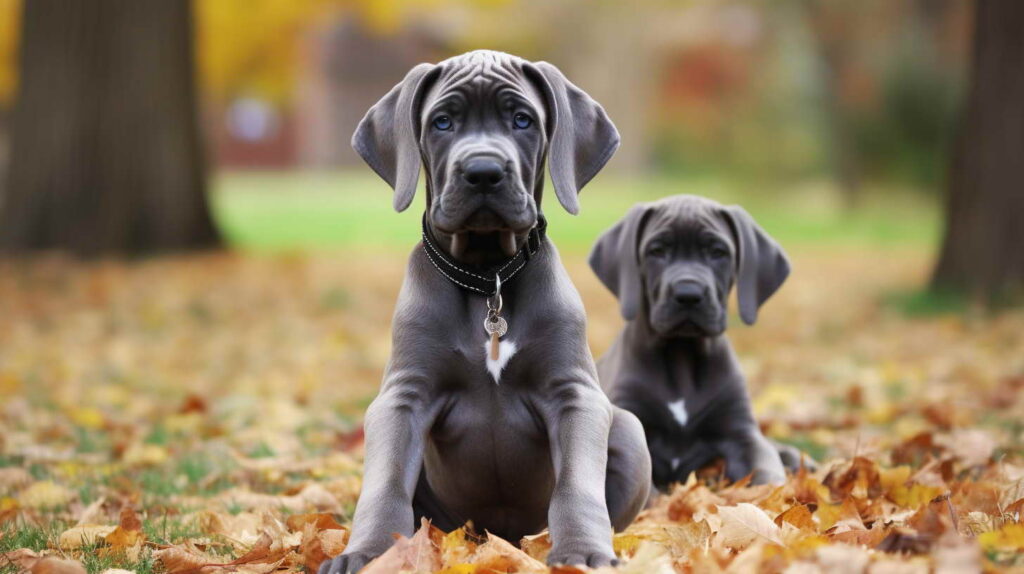
Housetraining Tips
Housetraining is one of the first priorities with a Great Dane puppy. Use these tips to get through this process as quickly as possible:
- Establish a consistent daily routine for feeding, playing, training and potty breaks.
- Take your puppy outside frequently, especially first thing in the morning, after confining, after meals, after playtime, and before bedtime.
- Praise and treat your puppy for pottying outside. Avoid scolding accidents inside as it can inhibit going in front of you.
- Confine your puppy or keep them leashed when indoors until housetraining is reliable. This prevents sneaking off to go inside.
- Watch for circling, sniffing, whining or leaving the room. These are signs they need to go out.
- Use an enzyme cleaner to remove all odors from accidents inside. Lingering scent can encourage repeat elimination in the same spot.
With vigilant supervision, routine, and positive reinforcement, most Great Dane puppies can be fully housetrained by 6 months of age. Crate training helps tremendously with this process. Be persistent and vigilant.
Bite Inhibition
Great Dane puppies explore the world with their mouths, which can lead to playful mouthing and biting behavior. These tips can curb biting:
- Provide sturdy chew toys to relieve discomfort during teething. Rotate through different toys to prevent boredom.
- Use reverse time-outs if your puppy gets over-excited and bitey during play. Leave the area briefly and ignore them to teach biting ends playtime.
- Discourage mouthing hands and limbs immediately. Say “no!”, redirect to a toy and praise for chewing appropriately.
- Practice positive reinforcement when your puppy licks or nuzzles gently instead of biting.
- Avoid wrestling games that encourage your puppy to jump up and nip at you.
- Enroll in puppy socialization classes so they learn bite inhibition from other puppies.
- Consider a temporary bitter anti-chew spray deterrent if biting behavior persists.
With diligent training and socialization, your Great Dane will outgrow the oral exploration phase and learn to play gently.
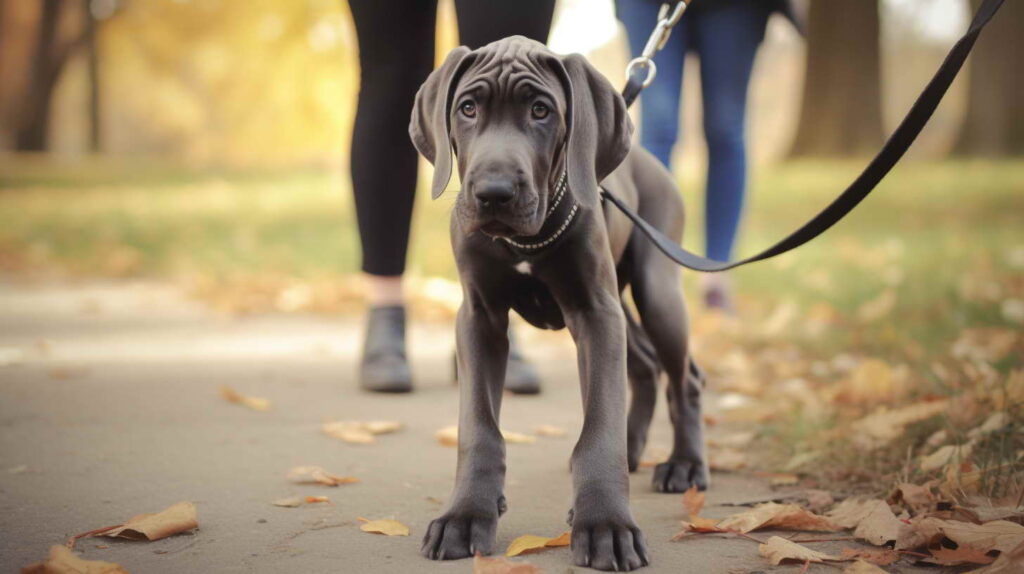
Leash Training
Leash training for large dog breeds like Great Danes is essential for teaching polite walking manners. Start early and make it a positive experience:
- Introduce the collar and leash in a safe environment like your home or yard at first. Pair with treats so they associate it positively.
- Start with short 5-10 minute training sessions and increase the duration gradually as your puppy masters the skill.
- Reward your puppy with praise and treats for staying near your side or looking up at you while walking.
- Practice stopping and sitting periodically to reinforce your control over the walk, not your puppy.
- Work up slowly to walking in different locations with distractions around. Maintain focus on you through rewards.
- Keep an upbeat, encouraging tone during leash training. Don’t repeat commands over and over.
- Use a front-clip harness if your Great Dane tends to pull constantly. The leash attachment spot turns them toward you if they lunge.
- Never drag your puppy with the leash or yell. This teaches them to resist and shut down. Stay positive.
With regular, positive training sessions, your Great Dane will become a polite walker who looks to you for guidance. This makes neighborhood walks relaxing!
Socialization
Socialization for Great Dane puppies is crucial to prevent fearfulness and encourage confidence in all situations. Use these tips:
- Safely introduce your pup to new people, environments, children, other pets, and anything unusual they may encounter in daily life.
- Attend puppy socialization or training classes to interact with new dogs and people.
- Invite friends over regularly so your puppy becomes comfortable with guests. Teach people how to approach and pet them appropriately.
- Arrange positive experiences for your puppy that involve car travel, city sounds, bicycles, skateboards, noises, crowds, and anything potentially intimidating. Pair with treats to build positive associations.
- Expose your puppy to grooming routines like bathing, nail trims, and brushing from an early age so they accept handling more easily.
- Socialize your Great Dane to people of all appearances, abilities, and backgrounds to prevent prejudice toward any group of people.
With broad socialization experience from a young age, your Great Dane will develop into a friendly, confident dog. Continue socializing with them throughout their life.
Mental Stimulation
Great Danes are intelligent, active dogs that thrive when mentally and physically stimulated. Here are some tips:
- Begin obedience training early and teach advanced skills over time like scentwork or competitive obedience.
- Provide interactive puzzle toys that dispense treats or kibble as your puppy plays with and manipulates them. Introduce different types to prevent boredom.
- Hide treats or toys around your home or yard and encourage your puppy to hunt for them. Increase difficulty over time.
- Use food-dispensing toys during meals so your puppy has to work for their kibble. This provides mental exercise.
- Play fetch games and teach your Great Dane to retrieve different objects by name.
- Rotate frequently between a variety of toys to keep your puppy engaged and interested.
Puppy Proofing Your Home
Great Dane puppies grow rapidly into a very large dog. Take steps to puppy proof your home right away:
- Use baby gates as necessary to limit access to parts of the home until housetraining and chewing behaviors improve.
- Keep electrical cords, household toxins, medications, and other tempting but unsafe items secured and out of reach.
- Remove delicate household objects and valuables that could be broken or chewed.
- Hide garbage cans inside closets or cabinets so your puppy isn’t tempted to scavenge. Consider locking lids.
- Supervise access to soft furnishings and cushions since digging and chewing behaviors are common in puppies. Provide alternatives like a dog bed.
- Keep counters and table tops free of tempting food items. You can also apply double-sided sticky tape to deter counter surfing.
- Ensure your puppy is supervised when loose in your home during their destructive chewing phase. Redirect to appropriate chew toys.
- Create a designated, safe play space for your puppy indoors when you cannot watch them. Use baby gates to keep them contained.
- Keep toilet seats closed and bathroom doors shut to prevent drinking from the toilet. Consider clipping on short leashes for supervision.
Puppy proofing creates a safe environment and prevents destructive or unhealthy behavior in Great Danes until they outgrow the puppy behaviors.
Positive Associations
Creating positive experiences for your Great Dane during training will build an emotionally strong, confident dog. Here are some tips:
- Socialize your puppy to new things gradually while providing treats and praise so new stimuli become associated with good things.
- When introducing anything potentially frightening like bicycles, scooters or loud noises, pair with high value treats to override any anxiety. Go slowly.
- During grooming routines, give treats continuously to distract from handling that may seem unpleasant or uncomfortable at first.
- Rather than scolding fearful behavior, redirect your puppy to a positive behavior and reward. This teaches confidence.
- Provide new toys or chews during times alone in the crate or playpen so solitude becomes associated with good things.
- Handle and examine your puppy frequently, giving treats as you do. This teaches them to accept handling from veterinarians also.
- Invite friends over regularly while your puppy is young so guests are strongly associated with attention, treats and fun.
Creating positive experiences from a young age is the most effective way to raise a happy, emotionally stable Great Dane that takes new experiences in stride.
Adolescence Challenges
The adolescent period between 6-18 months of age brings many physical and mental changes that can be challenging with Great Danes:
- Continue obedience training and socialization regularly to keep your dog focused on you for guidance as they test boundaries.
- Monitor your Great Dane closely when interacting with children or smaller dogs. Their size and energy level increases, necessitating more supervision.
- Discourage rough play or jumping up which could injure someone accidentally. Redirect to appropriate toys instead.
- Increase structured exercise during adolescence to prevent frustration and destructive behaviors when energy levels are high.
- Consider advanced training like competitive obedience or agility to challenge your dog mentally and physically during this life stage.
- Persist with housetraining. Adolescent dogs may periodically forget and need reminders.
- Spay/neuter your Great Dane before maturity to prevent some hormone-driven behaviors like roaming or mounting. Discuss timing with your veterinarian.
Great Danes are still impressionable during adolescence. Stay dedicated to training and socialization and you’ll raise an amazing canine companion.
Training Throughout Life
Proper training and socialization starting in puppyhood lays the foundation for a well-behaved Great Dane, but doesn’t stop after adolescence.
- Maintain obedience training throughout your dog’s life. Increase training difficulty over time by adding distractions or integrating new cues.
- Continue socializing your Great Dane to new places, people and experiences. This builds confidence.
- Address any emerging problem behaviors immediately through positive reinforcement techniques and consultation with a trainer if needed.
- Teach your Great Dane to accept grooming routines, veterinary handling, being crated when needed, and any other tasks that improve quality of life. Use treats and praise for cooperation.
- Monitor your Great Dane for signs of cognitive decline as a senior and adjust training routines accordingly by simplifying cues, slowing pace, and increasing motivation.
- Keep training sessions with an aging Great Dane short, positive and focused. Discontinue if they seem stressed or fatigued.
Regular training and socialization from puppyhood through your Great Dane’s senior years keeps them mentally sharp, confident, obedient and bonded to you. This maximizes their quality of life as your companion.
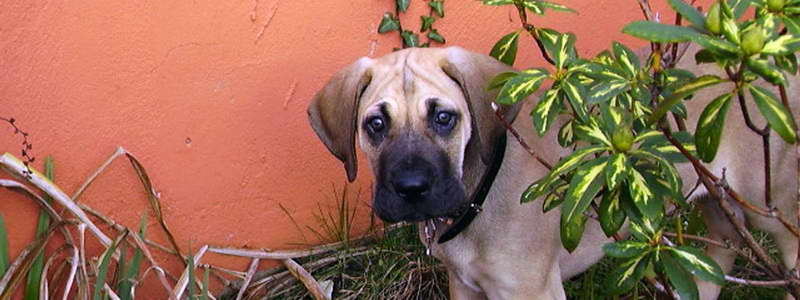
Conclusion
The first year with a Great Dane puppy brings rapid growth and impressions that set the tone for your dog’s future behavior and temperament. Use positive, humane training techniques to nurture your pup into a happy, mannerly, well-socialized companion. With time, patience, and consistency, your beloved Great Dane will bring you years of joy and loyalty.
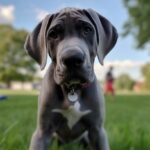
Leave a Reply